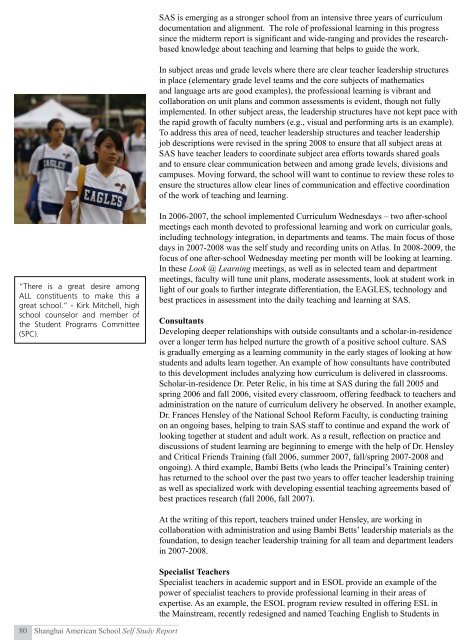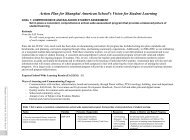Curriculum and Instruction - SAS-WASC
Curriculum and Instruction - SAS-WASC
Curriculum and Instruction - SAS-WASC
Create successful ePaper yourself
Turn your PDF publications into a flip-book with our unique Google optimized e-Paper software.
<strong>SAS</strong> is emerging as a stronger school from an intensive three years of curriculumdocumentation <strong>and</strong> alignment. The role of professional learning in this progresssince the midterm report is significant <strong>and</strong> wide-ranging <strong>and</strong> provides the researchbasedknowledge about teaching <strong>and</strong> learning that helps to guide the work.In subject areas <strong>and</strong> grade levels where there are clear teacher leadership structuresin place (elementary grade level teams <strong>and</strong> the core subjects of mathematics<strong>and</strong> language arts are good examples), the professional learning is vibrant <strong>and</strong>collaboration on unit plans <strong>and</strong> common assessments is evident, though not fullyimplemented. In other subject areas, the leadership structures have not kept pace withthe rapid growth of faculty numbers (e.g., visual <strong>and</strong> performing arts is an example).To address this area of need, teacher leadership structures <strong>and</strong> teacher leadershipjob descriptions were revised in the spring 2008 to ensure that all subject areas at<strong>SAS</strong> have teacher leaders to coordinate subject area efforts towards shared goals<strong>and</strong> to ensure clear communication between <strong>and</strong> among grade levels, divisions <strong>and</strong>campuses. Moving forward, the school will want to continue to review these roles toensure the structures allow clear lines of communication <strong>and</strong> effective coordinationof the work of teaching <strong>and</strong> learning.“There is a great desire amongALL constituents to make this agreat school.” - Kirk Mitchell, highschool counselor <strong>and</strong> member ofthe Student Programs Committee(SPC).In 2006-2007, the school implemented <strong>Curriculum</strong> Wednesdays – two after-schoolmeetings each month devoted to professional learning <strong>and</strong> work on curricular goals,including technology integration, in departments <strong>and</strong> teams. The main focus of thosedays in 2007-2008 was the self study <strong>and</strong> recording units on Atlas. In 2008-2009, thefocus of one after-school Wednesday meeting per month will be looking at learning.In these Look @ Learning meetings, as well as in selected team <strong>and</strong> departmentmeetings, faculty will tune unit plans, moderate assessments, look at student work inlight of our goals to further integrate differentiation, the EAGLES, technology <strong>and</strong>best practices in assessment into the daily teaching <strong>and</strong> learning at <strong>SAS</strong>.ConsultantsDeveloping deeper relationships with outside consultants <strong>and</strong> a scholar-in-residenceover a longer term has helped nurture the growth of a positive school culture. <strong>SAS</strong>is gradually emerging as a learning community in the early stages of looking at howstudents <strong>and</strong> adults learn together. An example of how consultants have contributedto this development includes analyzing how curriculum is delivered in classrooms.Scholar-in-residence Dr. Peter Relic, in his time at <strong>SAS</strong> during the fall 2005 <strong>and</strong>spring 2006 <strong>and</strong> fall 2006, visited every classroom, offering feedback to teachers <strong>and</strong>administration on the nature of curriculum delivery he observed. In another example,Dr. Frances Hensley of the National School Reform Faculty, is conducting trainingon an ongoing bases, helping to train <strong>SAS</strong> staff to continue <strong>and</strong> exp<strong>and</strong> the work oflooking together at student <strong>and</strong> adult work. As a result, reflection on practice <strong>and</strong>discussions of student learning are beginning to emerge with the help of Dr. Hensley<strong>and</strong> Critical Friends Training (fall 2006, summer 2007, fall/spring 2007-2008 <strong>and</strong>ongoing). A third example, Bambi Betts (who leads the Principal’s Training center)has returned to the school over the past two years to offer teacher leadership trainingas well as specialized work with developing essential teaching agreements based ofbest practices research (fall 2006, fall 2007).At the writing of this report, teachers trained under Hensley, are working incollaboration with administration <strong>and</strong> using Bambi Betts’ leadership materials as thefoundation, to design teacher leadership training for all team <strong>and</strong> department leadersin 2007-2008.Specialist TeachersSpecialist teachers in academic support <strong>and</strong> in ESOL provide an example of thepower of specialist teachers to provide professional learning in their areas ofexpertise. As an example, the ESOL program review resulted in offering ESL inthe Mainstream, recently redesigned <strong>and</strong> named Teaching English to Students in80Shanghai American School Self Study Report



